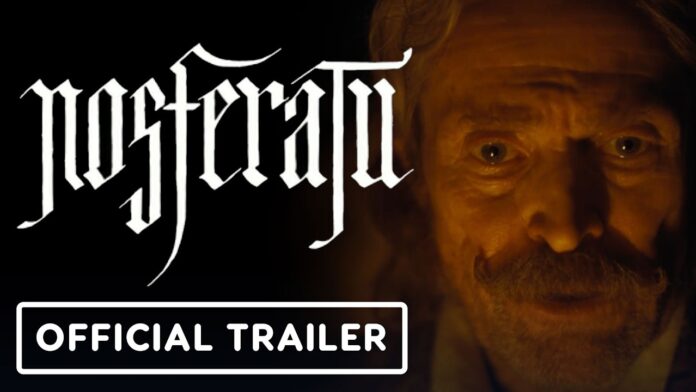The highly anticipated trailer for Robert Eggers’ Nosferatu showcases a haunting tale of obsession, set for release this Christmas.
After more than a decade of passionate pursuit, modern horror maestro Robert Eggers is poised to unveil his take on Nosferatu, the classic vampire tale. The full trailer, featuring a captivating ensemble cast including Bill Skarsgård, Lily-Rose Depp, Nicholas Hoult, and Willem Dafoe, immerses viewers in a world filled with dread and dark beauty.
Eggers, known for his ability to chill audiences through captivating narratives steeped in folklore and the supernatural, has once again created a haunting atmosphere reminiscent of his previous works, including The Witch, The Lighthouse, and The Northman. In this reimagining, viewers are introduced to Ellen, portrayed by Depp, who becomes the object of Count Orlok’s (Skarsgård) obsessive infatuation, echoing the themes of despair and desire that permeate classic Gothic literature.
The trailer unveils a meticulously crafted Victorian setting, characterized by an icy color palette and an oppressive atmosphere that evokes a sense of creeping dread. Unlike contemporary horror films that often rely on quick scares, Eggers opts for a slower, more unsettling build-up, ensuring that viewers remain on edge throughout. The teaser hints at a more pronounced psychosexual tension between Ellen and her husband Thomas (played by Hoult), adding depth to the story and setting it apart from previous adaptations.
In a conversation with Empire, Eggers confidently asserted that Nosferatu is “a scary film,” and the trailer certainly supports this claim. With glimpses of nightmares, unsettling imagery, and the presence of sinister rats, the film promises a terrifying experience that stays true to its roots while introducing fresh elements. The cast also includes Aaron Taylor-Johnson, Emma Corrin, and Ralph Ineson, further enhancing the film’s allure.
As anticipation builds, fans are preparing for a theatrical experience that combines Eggers’ distinctive storytelling with the rich legacy of Nosferatu. The film is set to premiere in U.S. theaters on Christmas Day, followed by its release in UK cinemas on New Year’s Day. With its haunting visuals and gripping narrative, Nosferatu is sure to be a standout film for horror enthusiasts this holiday season.
Analysis:
Political:
Robert Eggers’ Nosferatu serves as a reminder of the historical significance of vampire mythology in storytelling, which often reflects societal fears and anxieties. By tapping into these themes, Eggers can explore contemporary issues, such as obsession and the human condition, paralleling modern political climates where power dynamics often mirror the predatory nature of vampires. The film’s Gothic aesthetic may also resonate with audiences seeking escapism from current societal turmoil, highlighting the enduring allure of horror as a genre that challenges and critiques reality.
Social:
In a world grappling with mental health issues and relationship dynamics, Nosferatu delves into themes of obsession and desire. The psychosexual tension between Ellen and Thomas offers a lens through which audiences can examine contemporary relationships, particularly the struggles couples face in balancing love, trust, and personal demons. By addressing these themes within a horror framework, Eggers invites viewers to reflect on their own experiences and societal norms regarding relationships, particularly the impact of obsession on mental health.
Gender:
The film’s focus on Ellen’s character and her relationship with Count Orlok and Thomas speaks to broader gender dynamics in horror narratives. Traditionally, female characters in horror have often been depicted as victims or objects of desire. However, Eggers’ portrayal may subvert these tropes by showcasing Ellen as a complex character navigating her desires and fears. This shift reflects a growing trend in horror to empower female characters, allowing them to take control of their narratives rather than merely being pawns in a patriarchal structure.
Economic:
Nosferatu also highlights the intersection of horror and capitalism in the film industry. Eggers’ long journey to bring this project to fruition speaks to the challenges filmmakers face in securing funding for original and ambitious stories. The film’s anticipated release during the holiday season suggests a strategic move to capitalize on audience demand for horror during a time typically reserved for family-friendly fare. This juxtaposition not only reflects consumer preferences but also raises questions about the commercial viability of genre films in an ever-evolving cinematic landscape.
